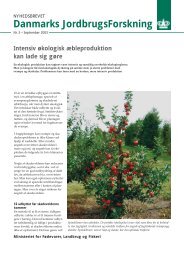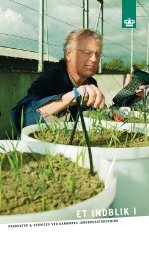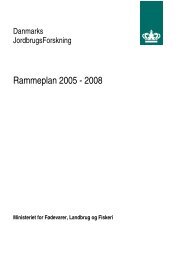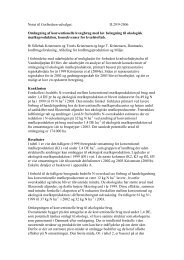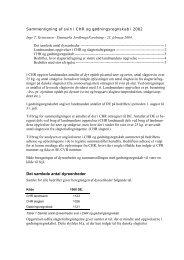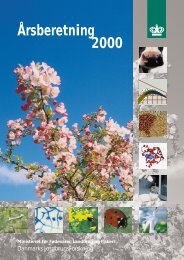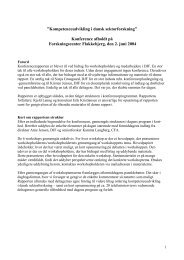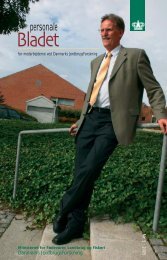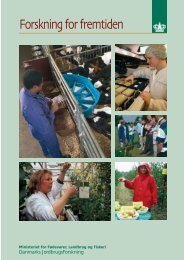Reproduction performances and conditions of group-housed non ...
Reproduction performances and conditions of group-housed non ...
Reproduction performances and conditions of group-housed non ...
Create successful ePaper yourself
Turn your PDF publications into a flip-book with our unique Google optimized e-Paper software.
- Paper III -<br />
together, the results from this study indicate a serious welfare problem for a few sows that<br />
are not able to cope in this kind <strong>of</strong> system. Also, the apparently overfeeding <strong>of</strong> the older<br />
sows may constitute both a welfare- <strong>and</strong> productivity problem. Locomotion problems<br />
(Dourmad et al., 1994) <strong>and</strong> a low feed intake during lactation, which may reduce ovulation<br />
rate <strong>and</strong> embryo survival (Zak et al., 1997; Han et al., 2000) <strong>and</strong> perhaps even conception<br />
rate (Hughes et al., 1984) are well-known consequences <strong>of</strong> high feed intake during pregnancy.<br />
It is therefore <strong>of</strong> outmost importance that managers <strong>of</strong> <strong>group</strong> feeding systems try to<br />
avoid this unequal feed allocation. Possible management initiatives might be assuring sufficient<br />
‘isolation pens’ for sows, which are not able to cope in the system, providing the feed<br />
on a larger area in systems with floor feeding. In systems with liquid feeding, setting up<br />
body partitions may have a positive effect (Andersen et al., 1999), however, it presupposes<br />
that the feed are equally divided in the trough, which is difficult to achieve in practice<br />
(Olsson et al., 1993).<br />
Aggressions, skin lesions <strong>and</strong> lying behaviour. Since it is well known that mixing <strong>of</strong> unfamiliar<br />
sows causes fighting between sows to settle social ranking (Arey & Edwards, 1998)<br />
it is not surprising that the level <strong>of</strong> aggressions were highest on the day <strong>of</strong> weaning. The<br />
first hour after mixing, the individual sow was in average involved in four aggressions,<br />
varying from 0 to 66. The study indicates that feeding stalls have a reducing effect on aggressions<br />
the first hour after mixing, as also found in a previous experimental study<br />
(Barnett et al., 1992). In view <strong>of</strong> the fact that sows in average spend 63 % <strong>of</strong> all observations<br />
in box the first hour after mixing; this is not surprising. Irrespective <strong>of</strong> layout, sows<br />
older than third parity were involved in more aggressions compared to younger sows the<br />
first hour after mixing. As sows had access to feeding stalls in the majority <strong>of</strong> herds, one<br />
explanation for this could be that the lower ranked sows stayed in the stalls during the most<br />
serious hierarchical fights to avoid aggressions.<br />
In general, as also found in other field studies (Gjein & Larssen, 1995; Andersen & Bøe,<br />
1999; Leeb et al., 2001), the skin lesions were mainly superficial lesions. The total number<br />
<strong>and</strong> length <strong>of</strong> skin lesions approximately five days after mixing was 28 <strong>and</strong> 66 cm respectively.<br />
In an experimental study with comparable scoring method it was found that number<br />
<strong>of</strong> skin lesions varied in average from 11.1 to 17.0 <strong>and</strong> length <strong>of</strong> skin lesions in average<br />
from 19.4 to 28.0 cm ten days after mixing in sows <strong>group</strong> <strong>housed</strong> in various pen designs<br />
(Barnett et al., 1992). The level <strong>of</strong> skin lesions has been assessed in several field studies (de<br />
Koning, 1985; Gjein & Larssen, 1995; Olsson & Svendsen, 1997; Andersen & Bøe, 1999;<br />
Leeb et al., 2001), however, due to differences in measurement <strong>and</strong> scoring methods it is<br />
difficult to use the results <strong>of</strong> these studies as comparison.<br />
80




